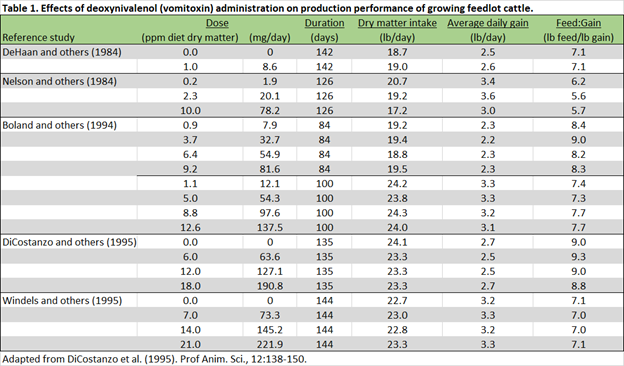How much vomitoxin is too much for feedlot cattle?
Posted on November 21, 2023
Source: Farm Progress. The original article is posted here.

By Jerad Jaborek, Michigan State University Extension
As ruminants, cattle have a rumen with a diverse microbiome that can breakdown various compounds into less toxic compounds, as demonstrated with vomitoxin (deoxynivalenol).
The weather Michigan, as well as other regions, experienced in 2023 was quite different from the norm and created an ideal environment for fungi that can produce mycotoxins. Particularly in the Thumb region of Michigan, a lack of rain and drought was experienced during the early summer followed by plenty of rain during late summer months. Weather summary data collected from weather stations in Richville/Frankenmuth and Lapeer areas, reported an average temperature of 66 degrees Fahrenheit, average humidity of 75% to 78%, monthly rainfall of 4.5 to 5.9 inches, and 11 to 13 days of rain in the month of August. The weather conditions experienced were prime for fungal and mold growth during the silking stage of corn development.
Fusarium species of mold prefer temperatures of 69 F or less with a relative humidity over 70%. Fusarium graminearum being one of the most common species responsible for producing vomitoxin and responsible for gibberella ear and stalk rot of corn. Vomitoxin, also known as deoxynivalenol (DON) is a type B trichothecene (i.e., mycotoxin) that can occur in grains such as corn, wheat, barley, oats and rye, as well as others.
The U.S. Food and Drug Administration (FDA) has set advisory levels for DON concentration allowable in grains allowed for human food consumption or animal feed consumption. The FDA has set advisory levels at 1 ppm DON for grains destined for human consumption, meaning grains with a greater DON concentration need an alternative use. The advisory levels set by the FDA for feeding DON contaminated grains (88% dry matter basis) to ruminating beef cattle greater than 4 months old are as follows:
10 ppm DON in grains and grain by-products
30 ppm DON for distiller grains, brewer grains, gluten feeds/meals
Recommended that the TMR not exceed 10 ppm DON

Research studies conducted in the 1980s and early 1990s investigated the effects of feeding DON contaminated grains to feedlot cattle (Table 1). University of Nebraska researchers conducted two studies feeding DON contaminated wheat to feedlot cattle. In the first study conducted by DeHaan and others, 0 vs. 1 ppm DON in the diet was fed for 142 days and resulted in no differences in average daily gain (ADG), DMI (dry matter feed intake), or feed to gain ratio (F:G) of steers and heifers. In the second study by Nelson and others, 0.2 (corn control diet), 2.3, and 10 ppm DON concentrations were tested in the experimental diets fed to steers and heifers for 126 days and resulted in no pathological or toxicological differences due to feeding scabby wheat.
Research from North Dakota State University by Boland and others investigated feeding barley contaminated with DON to feedlot cattle in a growing diet for 84 days and finishing diet for the remaining 100 days on feed. Four levels of DON concentration were fed: 1) 0.9 ppm, 2) 3.7 ppm, 3) 6.4 ppm, 4) 9.2 ppm during the growing period and increased to 1) 1.1 ppm, 2) 5.0 ppm, 3) 8.8 ppm, 4) 12.6 ppm during the finishing period. No differences were observed for ADG, DMI, F:G, and carcass characteristics. Anderson and others from North Dakota State University fed either 10 or 15 ppm DON barley diets to heifers during mid/late-gestation and during lactation, respectively, and observed no differences in heifer ADG, DMI and calf birth weight.
Greater concentrations of DON contaminated barley were fed to feedlot steers by researchers from the University of Minnesota. DiCostanzo and others fed 75% barley diets containing either 0, 6, 12 or 18 ppm DON in the diet for 135 days and observed no differences in ADG, DMI, F:G and carcass characteristics. Similarly, Windels and others fed 79% barley diets containing either 0, 7, 14 or 21 ppm DON in the diet for 144 days and observed no differences in ADG, DMI, F:G and carcass characteristics.
Overall, feeding DON contaminated grains in feedlot cattle diets up to 21 ppm did not result in any adverse health and performance effects. Additional data on the effects of DON concentration in diets feed to beef cattle are limited, including the maximum tolerance level of DON contamination cattle can process in their diet.
Being ruminants, cattle have a rumen with a diverse microbiome that can breakdown various compounds into less toxic compounds, as demonstrated with DON. It appears that DON can be degraded before being absorbed to illicit its toxicological effects observed in other species, such as swine. The concentration of DON in grains that is willing to be accepted by grain elevators varies, so make sure to inquire. Feeding grain or grain silages contaminated with DON to cattle destined for slaughter is a good alternative compared to a complete loss of a grain crop.

.jpg?disable=upscale&width=1200&height=630&fit=crop)


